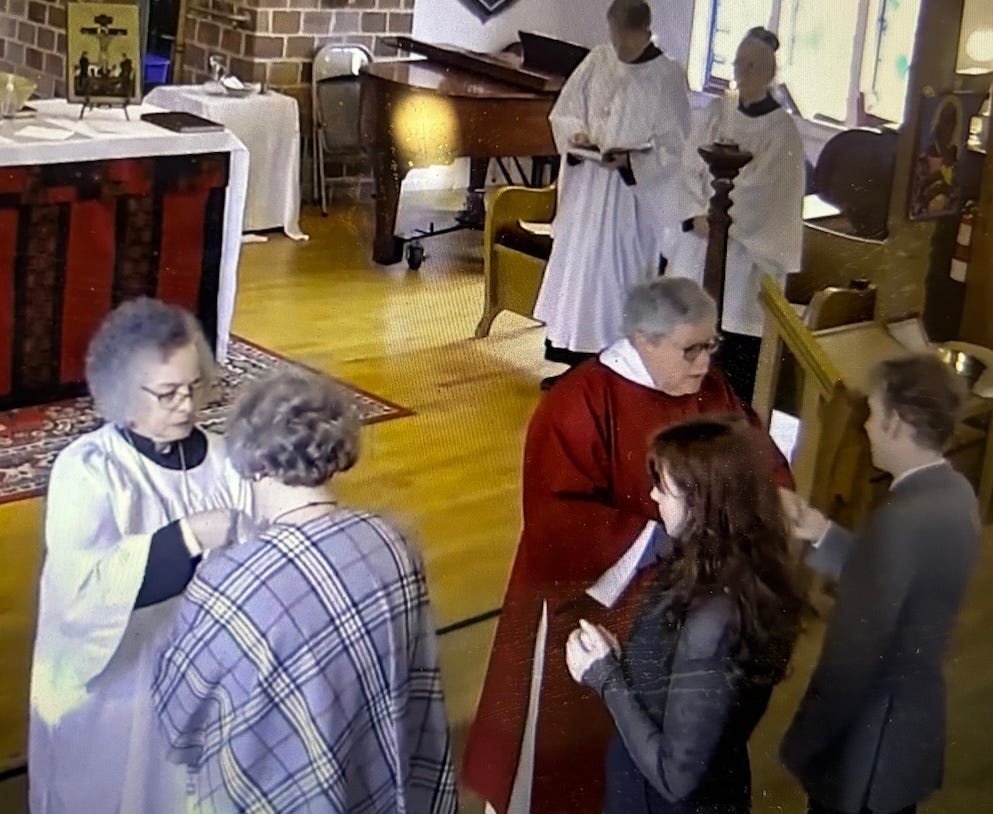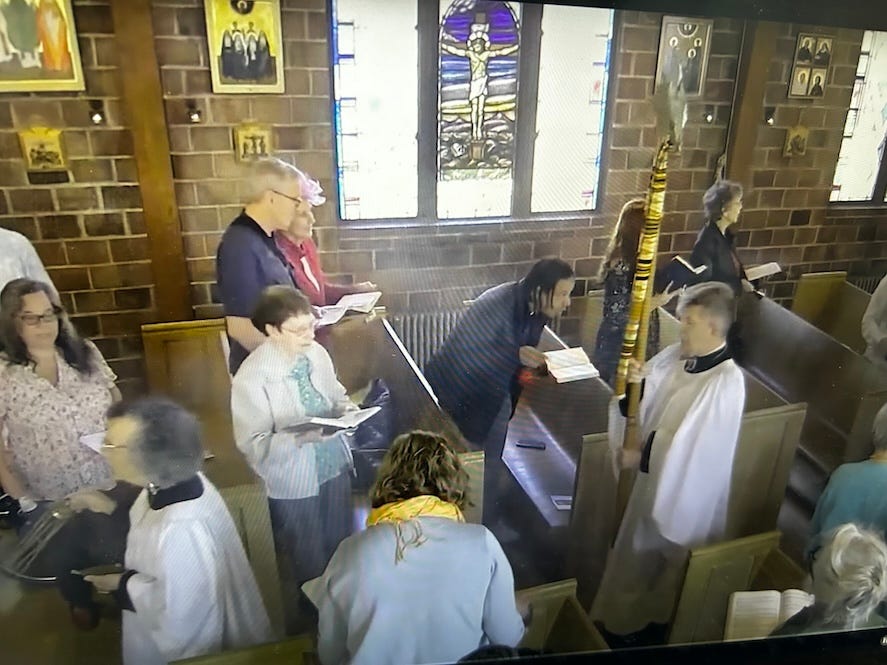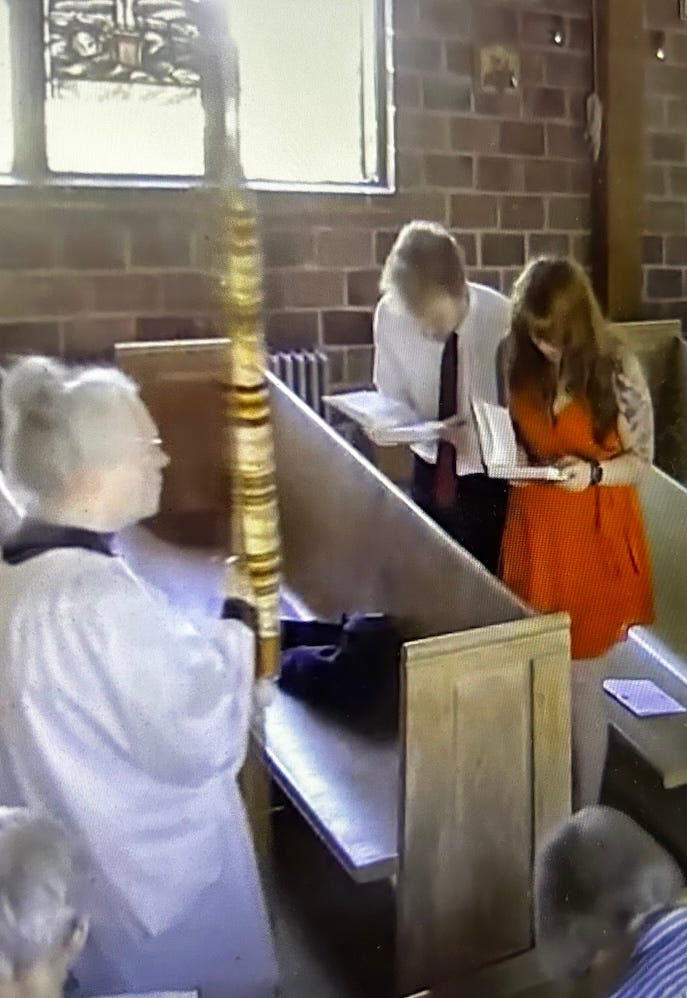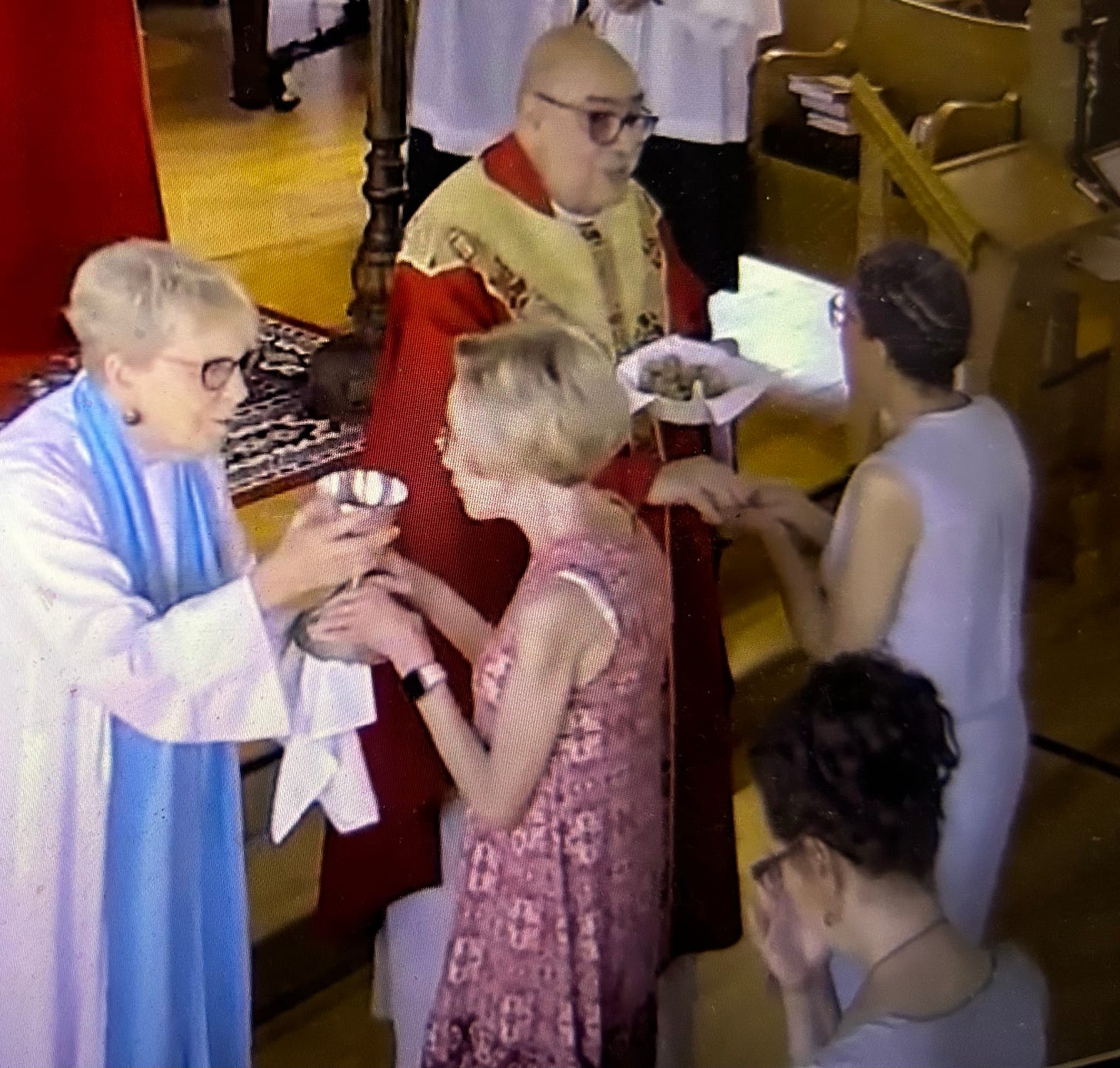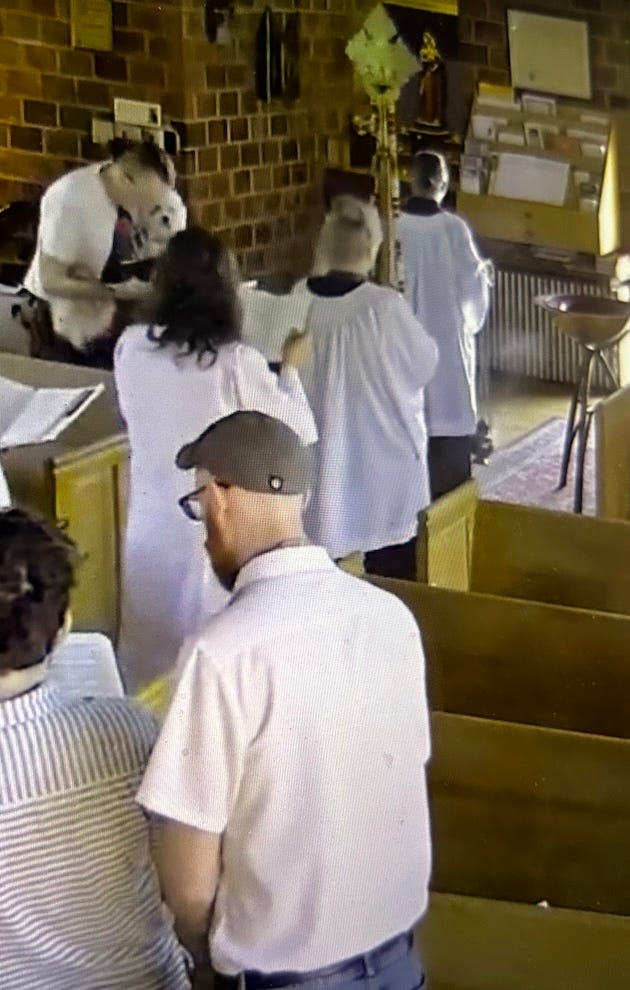Is St. Clements, Seattle poised for growth? Part Three
We ourselves are to be places where heaven and earth come together
Please, before you read this, look at Part One and Part Two
Parish identity and culture
I see two tasks most parishes, including St. Clement’s, would need to address to prime themselves for growth. First, effectively communicate the best of the parish to people outside the parish. Second, shape a healthy, dense culture that offer’s Thornton’s contagious holiness, that generates the “buzz” needed for growth.
The starting place
Over the last couple of years at St. Clement’s we’ve engaged in a series of exercises around identity and culture. It’s been a time of reflection and discernment, of debate and creative struggle.
We rated our living of the purposes of a parish church,[i] in 2022.
The worship of God - fullest Prayer Book Patter of a Sunday Eucharist, a public Daily Office (daily), and equipping members for personal devotions (especially reflection)
Pretty good, with about a third of us seeing a need for improvement.
Great Sunday Liturgy and social time
Much as in the above
The formation of the People of God - Fullest expression is a strong adult process in the tradition of the Episcopal Church - the total impact of Liturgy, spiritual guidance, overall parish climate, programs. At least 1/4 of those present on Sunday are very competent in the spiritual practices of the Episcopal Church.
Weaker, a bell curve over the midpoint
Having a sanctifying relationship with the broader community.
Middle and low ratings
An overall satisfaction rating looked like this -
So, room for improvement but maybe not enough dissatisfaction to create a sense of urgency and persistence around needed change. See the Change Formula. This might mean that parish leaders who see the necessity of change would need to engage their own sense of urgency and persistence along with the wisdom to keep things moving while not becoming too annoying about it.
I’ll return to the purposes of a parish church when we look at cultural density.
Describing ourselves
Over several sessions we asked a series of appreciative questions like: What is at the heart of this parish?, What has the parish done "really well" over time? and What have been the high points in the life of the parish during the past two years? - - When did people fell most alive, excited, energized, involved, committed, fulfilled, etc.?
A report at the end of five sessions said-
Liturgy with its music and beauty, our worship space, and our time together in coffee hour – all strengths (this was also picked up in our use of Some Key Factors and Incorporation Process Assessment )
Formation and Sanctifying Relationship with a broader community (showed less strength in the same assessments). Interest in relationships – neighborhood, music community.
A small Anglo-Catholic Parish with an African American heritage – the ground of our self-definition, a starting place. With our strengths in liturgy and social connection as factors as parts of our life that help people stay with us.
In Parish Options we saw membership growth and increased financial giving as pathways forward. And property redevelopment as something to be explored to see if it was viable. We have already increased our pledging.(More on Parish Options Model - See Parish Options Appendix A in An Energy Not Its Own and Parish Options, a 2 page PDF)
Parish size – an overwhelming desire to remain small but to grow from an average attendance of about 40 to someplace between 56 and 100.
People were blunt about specific areas of strengths and weaknesses while also being generally satisfied with parish life and ministry. It was a significant moment. We could be honest with one another. We could disagree with one another. The rector showed an openness to the process and the information. There was no overt defensiveness on the part of key leaders.
With an adequate degree of clarity about who we are the parish can move onto how we communicate that externally and how we might strength the cultural density around those gifts.
Clearly communicate the best of the parish’s identity and culture
Are you communicating the best of your parish to those outside the parish? When you do that two things are happening. First, you are providing the kind of information potential members need as they make an informed, free choice, which in turn sets them up to develop a stronger internal commitment. (See Intervention Theory material: a one page description and a section of chapter 6 in Finding God in All Things). Second, you are reinforcing in the congregation’s mind and heart the parish’s ways of doing things and its values. You are building a healthy cultural density.
Once you have an adequate and true read on the parish’s gifts and strengths you want to identify all the external communicators, e.g., website, signage, outside banners. You might include the Sunday bulletin because it is part of the first impression material visitors see.
Do the communication vehicles of the parish present a compelling image of the church? Do they communicate a sense of the climate in the parish? Are things presented in a way that tugs at the heart? How might all of that be improved? At St. Clement’s we might explore how our instruments of communication affirm our Anglo Catholic identity and African American heritage. Do they generate interest, buzz, curiosity in those who might be inclined to value those characteristics?
This is my current read on the question. I think overall, we do well enough, and we could do better. That said, I’m a bit anxious about this section because in naming “what we can do better” I fear offending some lovely people. So, I rely on their mercy and forgiveness and the increasing value the parish has expressed regarding truth and transparency. I’m also going to avoid going too far into the question because the task here is to stimulate the parish to do this work and not be put in a position of reacting or responding to my thoughts. So, just a few thoughts.
The phrase “An Anglo Catholic parish with an African American heritage” does appear in the Sunday bulletin, on the website, and in the weekly announcements. On the website it’s prominent on the home page. Less so in the printed material, seems a bit wedged in.
Overall the photography is well done and communicates the identity and culture: The pictures communicate the Anglo Catholic aspect clearly; maybe the African American heritage could be strengthened.
The written material on the website is generally warm and friendly. Easy to read. I love the “Rector’s Page.” The “What is Anglo Catholic” page offers an interesting historical background. It might be strengthened with an introduction that focuses on Anglo Catholic spirituality, what that offers to modern society, and how that tradition has captured the heart of so many.
Just a word about “warm and friendly.” I believe this applies to every parish church. They all say, “We are a warm and friendly parish.” At St. Clement’s we saw that in a number of comments about the character of the parish. The sense of community is strong. However, my parish and all other parish have to come to terms with how all churches say they are “warm and friendly.” Parish’s don’t describe themselves as “cold and hostile”, “inflexible and judgmental.” Though some are.
So, in terms of external marketing it’s not necessarily a draw. If people visit and they don’t experience it that is a problem. The key is to look at the ways in which the community behaves and ask, “what does a first time visitor experience.” We need to see it through their eyes. Parishes are warm and friendly usually for those who are already inside them. They often cut across their desire to include others by failing to make adequate space for newcomers in the first encounters and physical layout of the parish hall. Some show their desperation in too aggressively pursue the visitors.
Dense culture
I’ll begin by quoting from chapter 4 of A Wonderful and Sacred Mystery: A Practical Theology of the Parish Church.
“Our assumption is that a healthy and faithful cultural density makes for a richer, deeper parish life. A culturally dense parish contains more elements than other parishes; more habits, norms, skills, and dispositions in a strongly aligned relationship with one another. To use Edgar Schein’s approach, cultural density is a large number of practices that are in harmony with one another and with the espoused values and deeper underlying assumptions of the culture. … David Brooks wrote this about cultural density: “Some organizations are thick, and some are thin. Some leave a mark on you, and some you pass through with scarcely a memory.” He goes on to write, “A thick institution is not one that people use instrumentally, to get a degree or to earn a salary. A thick organization becomes part of a person’s identity and engages the whole person: head, hands, heart and soul.” That the Church is called, in Brooks’s terms, to be a thick organization is seen in the Great Thanksgiving of Rite One: And here we offer and present unto thee, O Lord, our selves, our souls and bodies, to be a reasonable, holy, and living sacrifice unto thee; humbly beseeching thee that we, and all others who shall be partakers of this Holy Communion, may worthily receive the most precious Body and Blood of thy Son Jesus Christ, be filled with thy grace and heavenly benediction, and made one body with him, that he may dwell in us, and we in him (BCP p. 336). …
“It may help to understand the idea of cultural density by focusing on broad segments and seeing it as a complex weaving together of elements. A quilt seems most like what we’re getting at. It may serve as an analogy. First there are the layers of fabric that form the basic construction—the backing fabric, batting in the middle, and the top layer of pieces stitched together. These layers are present in other dense cultures and come together to form an integrated whole. Stories of the beginning and stories of faithfulness under adversity, heroes, shared rituals, a common life of work and learning, a home in which they gather, a challenging entry/initiation process, time spent together in both the deeper and more routine parts of life. All this results in a distinct culture that offers participants identity and purpose. Members like the person called forth in that culture. Shaping such a strong parish life is the design and creation of a rich fabric. That fabric is the result of this process of bringing together these segments. Second there are the patchwork pieces themselves, those elements that provide the visible pattern and focus. The fabric has several primary pieces. We’ve talked about Eucharist, Daily Office, and reflection or personal devotions. Two other key elements are community and service. Then there are the quilting threads. The threads run throughout the three layers of fabric and throughout the pieces themselves, bringing the whole together—the process of sewing the layers together is itself “quilting.” The pattern of stitching adds beauty and strength to the whole—Benedictine spirituality, the existence of an apostolic core, adult formation processes, and for these times, special attention to matters of politics and faith. Remember, though, it’s an analogy—don’t press it too far.”
Using the quilt analogy we can make use of our work on the purposes of a parish church. Think of the purposes as a layer of the quilt.
Liturgy and the Sunday experience was seen as a strength. It’s something the parish does well. A form of Anglo Catholic liturgy that fits the culture of St. Clement’s. We might then use an appreciative strategy that builds upon that strength. In what ways might we enhance and grow what we do? A few examples, increased congregational competence in Eucharistic practices, enhancing the beauty and grace of the liturgy with new matching vestments for ministers of the altar and slightly more attention to Liturgical Presence. Also see the Eucharistic Assessment. Care needs to be taken to make improvements in a manner that maintains the existing climate of relaxed and comfortable ceremonial. We aren’t trying to become a small St. Mary’s Times Square.
Formation has already received some attention through a regular mid-week class. There may be some value in spending a couple of years with an emphasis in classes and sermons upon the two primary characteristics of the parish -- that we are “An Anglo Catholic Parish with an African American Heritage.” Helping members make stronger connections with the spirituality and delight of those features, enchantment. What John Orens points to when he writes of “our ability to enflame our neighbor’s hearts.” The language of N.T, Wright may be helpful, “We ourselves are to be places where heaven and earth come together.”
There’s an effort underway to address the Sanctifying Relationship purpose with the broader community, specifically the element having to do with serving the community. Their task is to identify something St. Clement’s can do well and is within the capacity of the congregation and that addresses a real need.
You may recall from Part Two that it is generally more effective to build upon the parish’s existing gifts and strengths then attempting to add new Driving forces. All the above needs to be considered with that in mind.
How do we get off the plateau?
You need to unfreeze the existing equilibrium, move it to a new level, and then refreeze it. I’ll say more about that in Part Four. For the moment I’ll highlight one factor, the strength of restraining forces must be reduced. See if you can identify a couple of restraining forces that are getting in the way of growth. If you’re to change the equilibrium you need a significant set of interventions. Consider two issues: what restraining forces may be easy to change? and which forces are the most substantial?
What combination of actions is likely to set off the buzz that will draw people to the parish and change the equilibrium?
The answer to that will vary from parish to parish and depend on the abilities of the parish leaders. Some parish leaders are great at seeing new possibilities. Some of them are also skilled at managing the actions needed to implement those possibilities. Others are competent administrators of the church’s routine business affairs but have no realistic idea of how to manage a turn around for a declining situation. Does the priest live close enough to the church to have a presence in the neighborhood? Does she have the needed health and energy? Are there enough parishioners able and willing to take on developmental tasks? Is there clarity about the difference between the routine business of the church and the developmental needs? All these and a dozen more factors will impact any effort toward growth. There are churches that will be able to move quickly on a range of development matters and others that will need to focus on one thing this year and another next.
At Saint Clement’s we are a small parish with many members who are unable or unwilling to take on specific tasks. Some no longer have the energy to do the kind of work needed. We may also place too much hope in younger new members who have lots of ideas but may lack stability and persistence or not adequately understand the purposes of a parish or the culture of this parish.
That limits how much we can accomplish in any year. We can dream more dreams than it's possible to act on. We have more good ideas than it is possible to bring to fruition.
That may mean at least two things.
We need to focus on just a few things that will advance the long term viability of the parish. And we need to do that while we also tend to the routine and maintenance matters of any church. It's the difficult task of strategic thinking and management that most small parishes are unable to engage effectively. (See more in Strategic Oversight of the Parish, especially the section sorting what is important and what is nor important. Also a more recent take on that in ”Making time for developmental matters” in chapter 4 of Finding God in All Things: Contemplation, Intercession and Intervention.)
Then we need to practice effective pastoral oversight which includes a mix of leadership, management and administration. Three skill sets rarely present in the same person, priest or lay leader. In fact rarely present or functioning in the collection of rector, wardens, vestry members, committee heads and task leaders seen in any parish, let alone any small parish.
Still, St. Clement’s like other small churches has to find a way that works for it. A way to plan and implement, to scan the whole and to focus on something attainable.
About the holiness thing
You may have noticed that Sister Michelle and I frequently return to Martin Thornton’s, “There is nothing so contagious as holiness.” I know the word makes some people uncomfortable. Off-putting they’ll say. So, I know I’m showing my bias. I think there are plenty of churches out there that will lead you to prosperity, that will align with your left-wing or right wing politics, that will smooth you and make you feel safe. So I understand it’s just me. I’m not interested in those kind of churches growing. I think there’s already too many of them. I am interested in the parts of even those churches where holiness can be seen and tasted. I’m invested in those parishes that understand they exist to worship God. N.T. Wright wrote, “We ourselves are to be places where heaven and earth come together.”
In Part Four we’ll look at contextual issues, facing the truth, our management issues, getting clear about our desire for growth, and need to unfreeze the existing equilibrium, move it to a new level, and then refreeze it.
This abides,
Brother Robert, OA
The Feast of Silas, Missionary Companion of Paul
[i] For background on the three purposes of a parish church see Chapter One, An Energy Not Its Own: Three cycles of parish life and the purposes of the parish church, Michelle Heyne & Robert Gallagher, Ascension Press, 2023.
Is St. Clement's, Seattle poised for growth?




